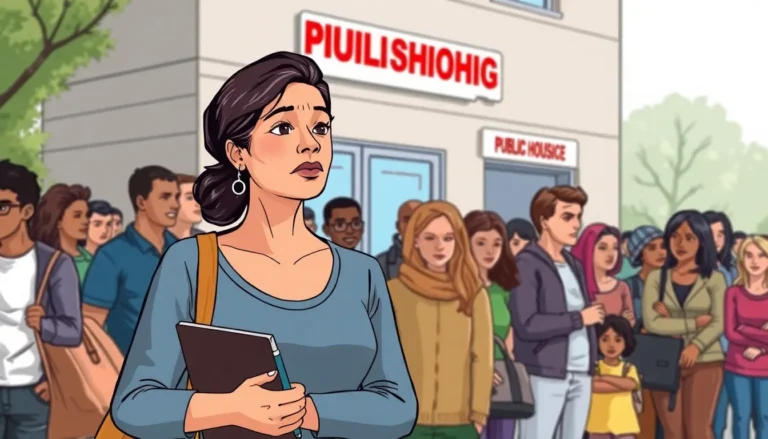Table of Contents
ToggleGentrification isn’t just a buzzword tossed around by hipsters at coffee shops; it’s a complex phenomenon reshaping neighborhoods across the nation. As states roll out policies that impact housing, businesses, and communities, the term “gentrification by state” becomes more relevant than ever. It’s like watching a game of Monopoly unfold, where the players are state governments and the properties are neighborhoods undergoing rapid change.
But what does this mean for the everyday person? From rising rents to the displacement of long-time residents, gentrification brings both opportunities and challenges. It’s a balancing act between revitalization and preservation, and understanding how state policies influence this dance is crucial. Buckle up as we dive into the quirky world of state-driven gentrification and uncover the hidden dynamics at play.
Understanding Gentrification by State
Gentrification varies significantly across states, shaped by specific policies and local economies. He or she can observe its effects on communities and individuals through unique lenses in different regions.
Definition and Context
Gentrification refers to the process of neighborhood change that involves an influx of more affluent residents displacing lower-income individuals. This transformation often leads to rising property values and rents. Many states implement policies that encourage development and real estate investment, which can accelerate gentrification. The complexity of this phenomenon lies in balancing urban revitalization with the preservation of community character. Communities face the challenge of ensuring that improvements benefit all residents rather than a select few.
Historical Perspectives
Gentrification’s roots trace back to the mid-20th century, when urban areas began experiencing decline. Economic shifts, such as deindustrialization, prompted the exodus of middle-class families to suburbs. Subsequently, artists and young professionals explored these neighborhoods, drawn by affordable housing. Over time, their presence attracted investments, leading to changes that often pushed original residents out. Notably, state-level policies and incentives have evolved, influencing these patterns by promoting redevelopment. Understanding historical contexts provides clarity on how current gentrification trends emerge and persist.
Economic Impacts of Gentrification
Gentrification significantly influences local economies. It not only transforms neighborhoods but also affects local businesses and property markets.
Effects on Local Businesses
Local businesses often experience both positive and negative impacts during gentrification. Increased foot traffic boosts sales for shops and restaurants, drawing affluent residents and visitors alike. Conversely, rising rents can strain long-standing businesses, leading some to close due to financial pressures. Customer demographics shift, changing demand for goods and services. Small, community-oriented enterprises sometimes struggle to compete with larger chain stores that move in, diluting the neighborhood’s unique character. Adaptive strategies, such as diversification or targeting niche markets, become crucial for survival during these transformations.
Changes in Property Values
Property values typically increase as neighborhoods gentrify. Affluent individuals moving in create higher demand for housing and drove prices up. Long-time homeowners may benefit from rising equity, while renters face escalating costs, which may force them to relocate. Speculative investments also contribute to property inflation, complicating the market landscape. The disparity between original residents and new homeowners often sparks tension as the cost of living rises. Policymakers grappling with these issues implement strategies to mitigate displacement and support affordable housing initiatives, striving to balance growth with community stability.
Social Consequences of Gentrification
Gentrification leads to significant social consequences, deeply affecting communities throughout various states. Residents face displacement and shifts in community dynamics.
Displacement of Residents
Displacement arises as property values surge, pushing original residents out. Many individuals, particularly low-income families, can’t afford the rising rents and taxes. Some studies show that up to 20% of residents in gentrifying neighborhoods may move due to financial pressures. Long-term residents often find themselves in communities that no longer feel like home. Those uprooted frequently relocate to areas farther from their jobs and support systems. Losing their neighborhood ties diminishes their sense of belonging. Without affordable housing options, entire communities may vanish, and the cultural fabric frays.
Shifts in Community Dynamics
Changes in community dynamics manifest as new residents move in. Newcomers often bring different values and lifestyles, which can clash with established traditions. Local businesses adapt to cater to wealthier patrons, altering the area’s character. Many original residents experience feelings of alienation in spaces that become unrecognizable. These dynamics foster a divide, leading to tensions between old and new inhabitants. Community events may shift focus, reflecting the interests of recent arrivals rather than long-standing locals. Increased policing or surveillance measures might accompany these changes, impacting social interactions. Overall, the transformation alters the landscape of neighborhoods, leaving lasting impacts on residents’ social cohesion.
Policy Responses to Gentrification
Various policies address gentrification’s impacts, aiming to balance growth with community stability. Two significant avenues include zoning laws and housing affordability initiatives.
Zoning Laws and Regulations
Zoning laws shape land use and development patterns, directly influencing gentrification outcomes. Cities may restrict development types or density to preserve community character, preventing rapid displacement. Some municipalities adopt mixed-use zoning, promoting diverse housing options while stimulating local businesses. Additionally, inclusionary zoning mandates a percentage of new developments to offer affordable units. Such regulations can mitigate the effects of gentrification by ensuring that lower-income residents remain in their neighborhoods. Effective zoning regulations reflect community input, promoting redevelopment efforts while safeguarding against displacement.
Housing Affordability Initiatives
Housing affordability initiatives exist to counteract displacement caused by gentrification. These initiatives often include funding for affordable housing projects and rental assistance programs. Communities may implement property tax relief for long-time homeowners to help them stay in their homes. Moreover, direct financial assistance programs provide support for low-income renters facing rising costs. Innovative approaches, such as community land trusts, empower residents by preserving properties for collective ownership. These strategies work collaboratively to maintain neighborhood diversity, ensuring that all residents benefit from local revitalization efforts.
Case Studies on Gentrification by State
This section examines specific urban areas and the lessons learned from different states regarding gentrification. Insights into these case studies reveal the nuances of the phenomenon across various regions.
Urban Areas Experiencing Gentrification
Cities like San Francisco, New York, and Washington D.C. exemplify significant gentrification trends. Rising property values create competition for housing, often displacing long-term residents. San Francisco’s Mission District illustrates the tension between community preservation and real estate development. Affordable housing options diminish as demand grows, affecting low-income populations. Brooklyn showcases rapid changes, with previously affordable neighborhoods now catering to wealthier residents. Washington D.C. experiences similar transformations, where historic neighborhoods face modernization efforts that threaten their cultural fabric. These cities serve as critical examples of gentrification’s complex dynamics and its consequences for diverse communities.
Lessons Learned from Different States
States encounter unique challenges and responses concerning gentrification. In California, inclusionary zoning helps integrate affordable units into new developments, promoting diversity. Conversely, Texas cities face tensions due to minimal regulations, resulting in rapid displacement without adequate support. Affordable housing initiatives in Oregon reveal effective strategies to manage growth while addressing community needs. The experience of New Jersey illustrates that proactive rent control measures can mitigate rising housing costs for vulnerable populations. By analyzing these varied approaches, other states can adapt strategies to balance development and community stability effectively.
Conclusion
Gentrification remains a multifaceted issue that significantly influences urban landscapes across the United States. The interplay between state policies and local dynamics shapes the experiences of residents, highlighting the need for thoughtful approaches to urban development. As communities grapple with the challenges of displacement and rising costs, innovative strategies can pave the way for more inclusive growth.
By prioritizing affordable housing and preserving community character, states can foster environments where both new and long-time residents thrive. The lessons learned from various urban areas emphasize the importance of balancing revitalization with social equity, ensuring that progress benefits everyone involved. Addressing gentrification requires ongoing commitment and collaboration among policymakers, residents, and developers to create sustainable neighborhoods that honor their rich histories while embracing future possibilities.








